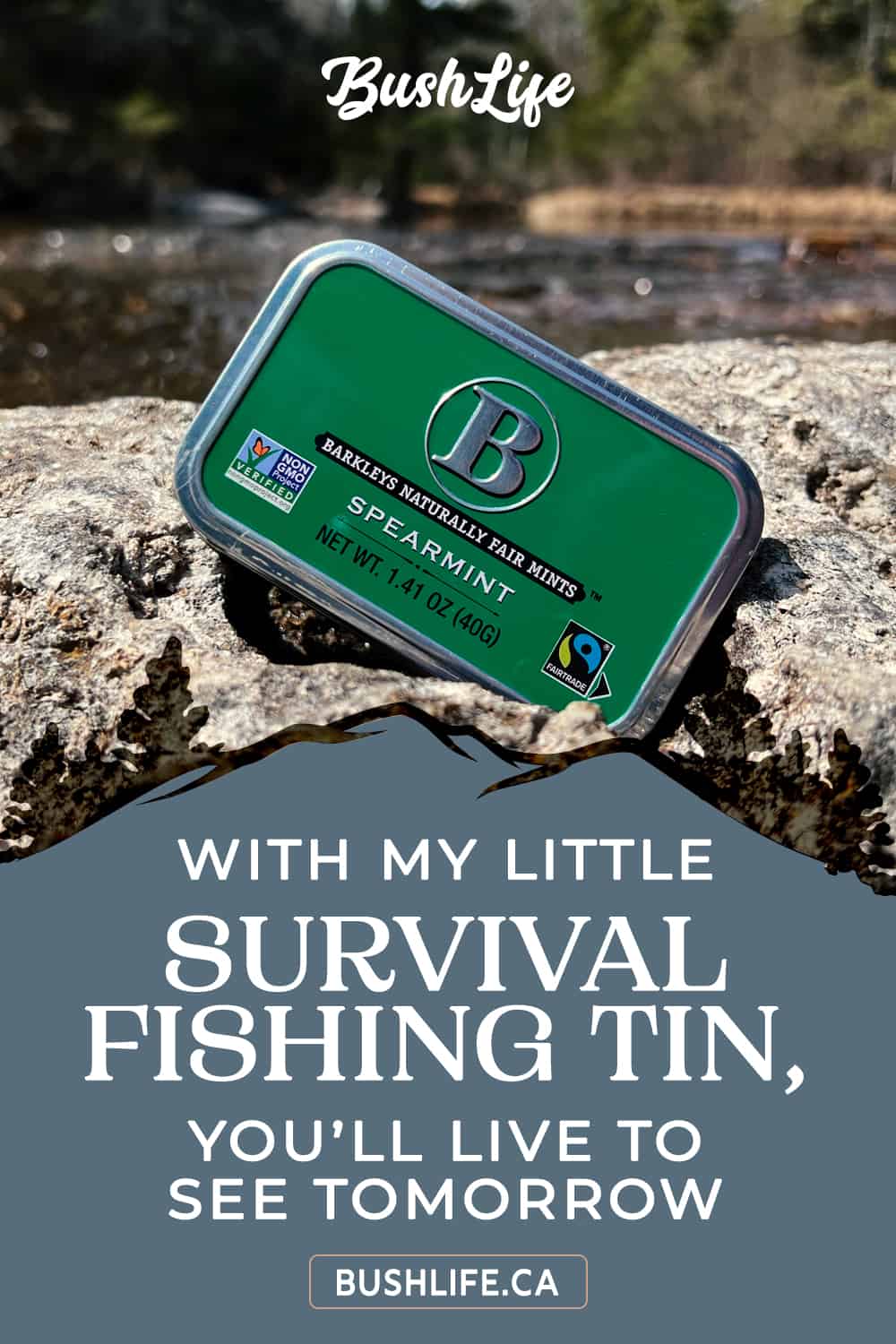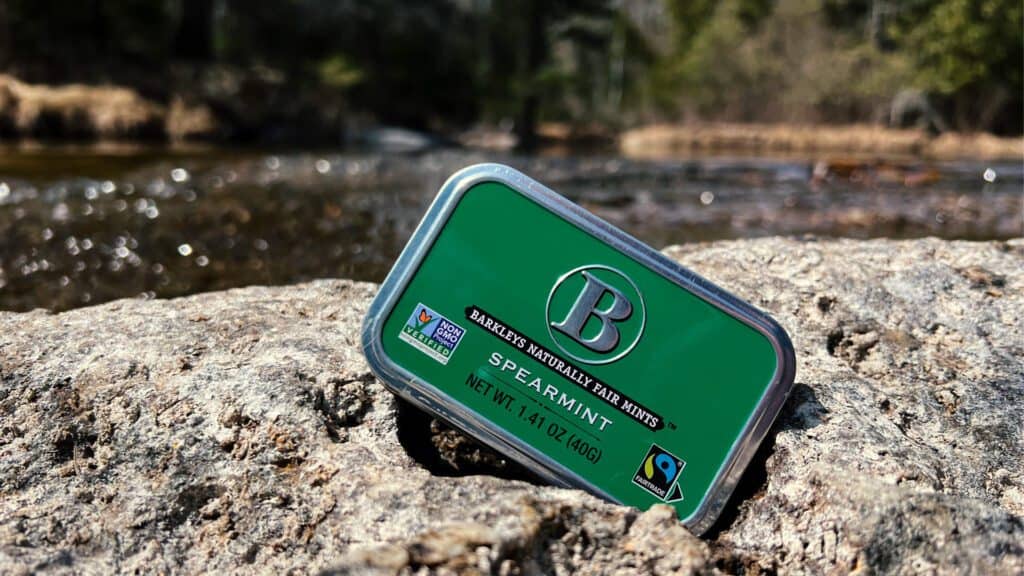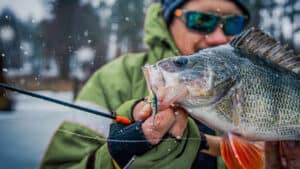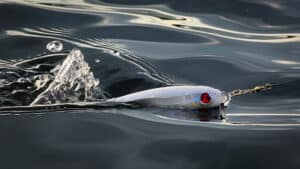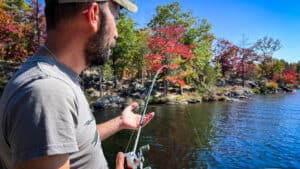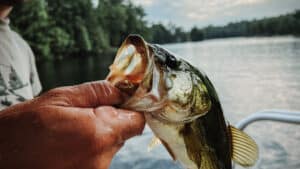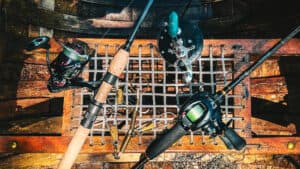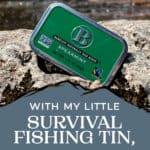Here’s a cool concept for you: The “Survival Fishing Tin!” One of my first posts on BushLife is Backpack Gear Load Out, where we cover what you should be carrying when heading into the woods. At least if you want to stay alive, let alone comfortable for those SHTF moments. Recently, we added Fishing Basics, which covers everything you need to know to start fishing. Now it’s time to bridge these two worlds and dive into the survival fishing tin.
Discloure: Posts may contain affiliate links. Purchases made through our links result in a small commission to us at no charge to you. We only recommend products that meet our brand standards based on testing and first hand use by our authors.
- What is a Survival Fishing Tin?
- Why Should Anyone Care About a Survival Fishing Tin?
- Components of the Survival Fishing Tin
- Can You Fish With So Little?
- Water is Everywhere!
- Snare Wire: The Hunting Component
- What Other Items Go Into a Survival Fishing Tin
- Can You Buy a Survival Fishing Tin?
- Level Up With Handline Fishing
- The Survival Fishing Tin
What is a Survival Fishing Tin?
Well, let’s start with the box. Before you toss out that metal Sucrets tin, think twice. It’s the perfect size and shape for a pocket-size survival tin. My Sucrets tin got beat up, and I’m onto a “Barkley’s Naturally Fair Mints” box. The brand doesn’t matter, it’s the size, shape and material that matters.
In this tin, we can toss in, cancel that we don’t, toss anything. We can neatly place the simplest items needed to catch fish. If placed neatly, the tin can hold a lot more. The tin is then easily carried in your pocket. Mine goes into my pack and has a permanent home there. It’s so light that you won’t even notice it’s there.
Why Should Anyone Care About a Survival Fishing Tin?
Well, ask yourself what’s in your backpack when you head into the woods. Perhaps some snacks. Maybe even some MREs. Most people I know don’t carry much of anything. So what happens if you get stranded or if your ATV breaks down? What happens if you are injured and can’t self-rescue? What if no one knows where you are? I can tell you the trails around my area see some action on the weekends, but they can get quiet during the week!
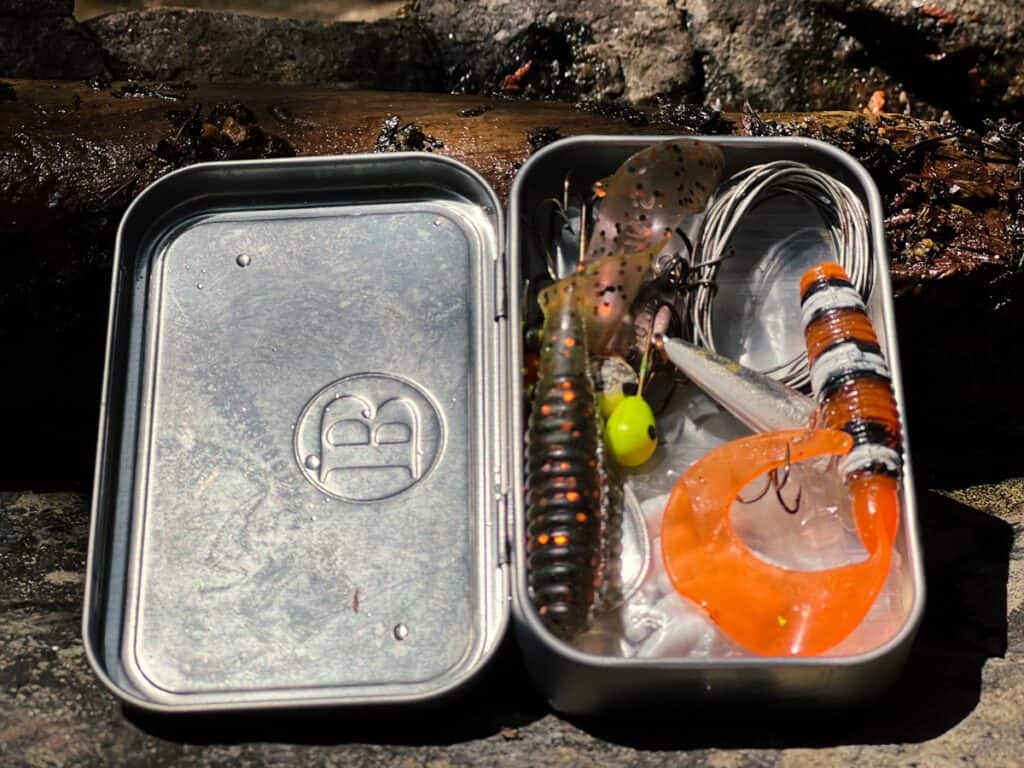
A human can survive for 1-3 months without food! That’s cool in a weird way. Unfortunately, it takes a massive psychological toll on people. Most would probably panic. While there is nothing to panic over with a short-term situation, it is comforting physically and mentally to be able to source some additional food.
As we eat, breathe, and even sleep, we consume calories. When we are out in the backcountry doing chores, even if setting up an emergency camp, we are naturally consuming a lot more calories. That being said, not replenishing those calories will take a toll. Add cold weather into the mix, and things get a lot worse as feeding helps the body with thermal regulation.
Components of the Survival Fishing Tin
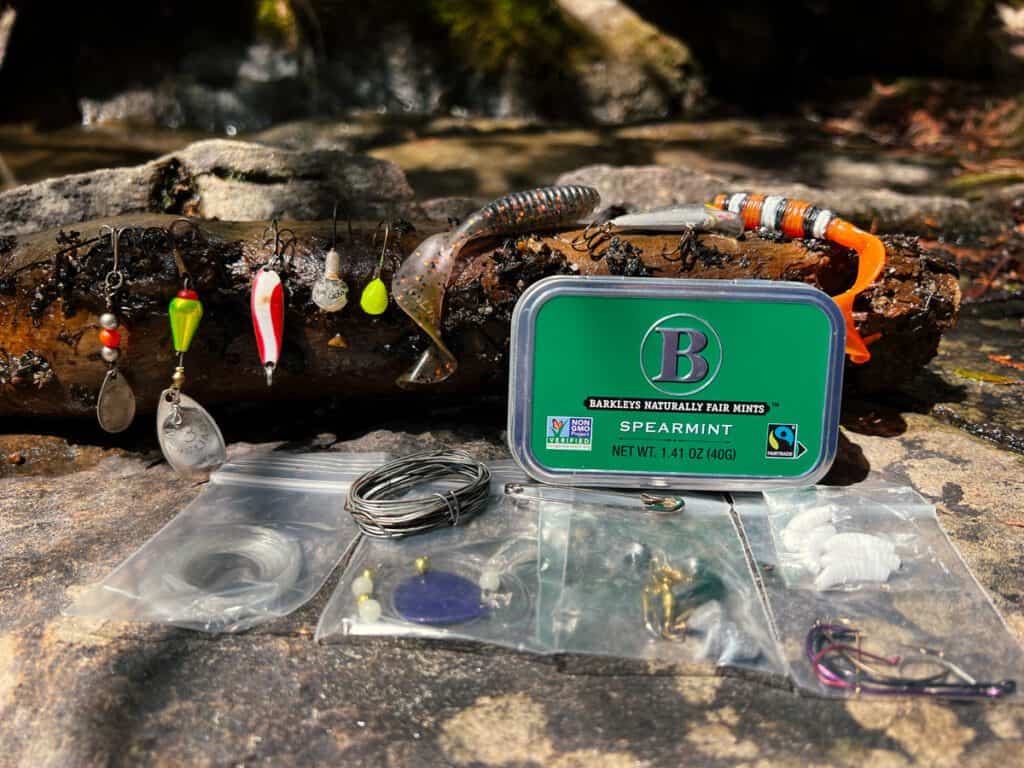
Hopefully, I caught your attention now! Let’s take a look at what’s actually in this tin.
- A small pack of plastics. I honestly don’t know what looks like fake maggots:) But there are 5 of them, which is appealing.
- Rubber worms (x 2 in different colours)
- Yellow jig x 1
- White jig x 1
- Mini Rapala (fake minnow)
- A Red & white spoon
- Yellow and red Mepps spinner with a silver spinner, triple hook
- A smaller beaded spinner, triple hook
- Swivels and weights
- Single hook assortment
- My infamous rubber worm rig (in a ziplock)
- Hank of fishing line (in a ziplock)
- Small safety pin x 1
- Snare wire!
Can You Fish With So Little?
Yes! It doesn’t take a $60,000 bass boat or a $400 fishing rod to go fishing. Take the fishing line from the tin and tie it to a branch – you now have all you need. If you need to get out farther, attach that fishing line to the snare wire or some paracord, and you are golden. All you need is something to grip and bring that fish in.
With this survival fishing tin, we have enough of a variety of fishing lures to catch the attention of whatever fish are nearby. Even military kits will often have less, sometimes as little as some hooks where you find your bait, such as worms.
Speaking of which, always carry a variety of fishing hooks. Small hooks can hook a bigger fish, but not the other way around. Even something as little as a sunfish looks like a big meal when you’re hungry.
Let’s not reinvent the wheel with this post. Fishing Basics already covers all the techniques and tips on how to fish. The point here is to cover what components you’ll need for your survival tin and the other things it can do.
Water is Everywhere!
Travelling through the Muskoka’s or Kawarthas, you’ll notice water everywhere! Forget that cottage country in Ontario, Canada is the land of the canoe and that you can travel across the country in a canoe. Even in the city, you can see how many rivers and streams exist. They weave above and below ground as they pass through. The point is where there’s water, there’s a good chance there’s fish.
In a survival situation, don’t discount land-locked water bodies. A friend of mine built a pond on his land, and he noticed a ton of fish in it! The birds carry the fish eggs on their feet, and as they move around, the eggs fall into other water bodies. My friend had so many fish that he opened his pond to the public as a fish farm.
Snare Wire: The Hunting Component
The snare wire in the survival fishing tin is there for catching small game. Technically, the post should read hunting and fishing survival tin.
A small snare wire is less to carry than a bow or firearm. For anyone not licensed, firearms are out anyway – and it can be a lengthy process to go through. You can purchase snare wire at your local hardware store and have peace of mind for your next outdoor adventure. You don’t have to get off the couch – you can even order snare wire online.
For snare wire, any light wire should do the job. Brass is ideal as it’s soft enough to mould into a snare yet strong. 24 gauge is a good start. The wire linked above is slightly heavier for rabbits.
How To Make a Trap with Snare Wire
You’ll want to tie a slip knot on one end of the snare wire and feed the other end through. The loop you just made should be large enough to allow the head of whatever animal you are after to fit right in.
For a bunny, that’s about the size of your fist. Make sure to set the trap off the ground at the height of where the animal’s head would be. Use sticks to position your snare. Then you leave and wait.
Nothing Was Stirring, Not Even a Mouse
I know, it’s not Christmas. But that line is also a hunter’s worst nightmare. My last hunt was for deer during black powder season with this giant 54-calibre muzzleloader. I mean a 175-year-old, heavy metal cannon that would kill any animal within a hundred yards of its old sights. I sat in the cold that afternoon, and nothing was stirring, not even a mouse! Fine by me – I enjoyed the scenery and shot the side of a hill to empty the gun. It’s the only way to do it safely:) Anyway, it got me thinking about a survival situation, and I’d be pretty hungry if that was one! I was also so damn cold, I don’t know if I could even hit a little squirrel while shivering so badly.
The point is, the snare is something you set up first and then go fishing or take care of chores around camp. That snare works for you 24/7 – all it takes is a little piece of wire. It’s too easy, so we add it to the survival fishing kit and don’t look back.
What Other Items Go Into a Survival Fishing Tin
The safety pin is a bonus, and if you have room, a razor blade wrapped in gorilla tape with a tiny Ferro rod won’t hurt either. It’s a means to a fire. If you don’t know what a Ferro rod is, I highly suggest reading How to Use a Ferro Rod.
As pictured, I don’t pack these fire-making items myself into the tin as it’s already well covered elsewhere in my pack. But the option is always there. The point is if you have any extra room, now’s the time to add any other critical items you may need.
At the very beginning of the post, we mentioned material. You can use the survival tin to char natural material for a future tinder source. That’s a post of its own for another day, but it aids in repeated fire-making.
As a last resort, and I mean, you are desperate and unprepared – you can even boil a tiny bit of water in it for safe consumption. And at last, the reflective inside of the tin can double as a signal mirror if you keep it clean and out of fire. That’s why we use a metal tin.
Can You Buy a Survival Fishing Tin?
Yes, however, if you already have fishing supplies, it’s more economical to create your own. If you don’t, I suppose by the time you add up all the little bits and pieces, it might be a wash in terms of price.
I cannot speak to the quality of a pre-fab survival fishing kit as I made it years ago and don’t plan on spending money on something I already have. But it is out there. Honestly, I didn’t even know it existed commercially until now. Curiosity took over before posting, and I’m pleasantly surprised to see it exists. Doubly pleased as it’s very similar to mine. Although, I do recommend adding the snare wire if you go this route.
Level Up With Handline Fishing
I’ve fished for almost 40 years and never heard of handline fishing until recently. Handline fishing is the oldest form of fishing, predating fishing rods. It’s also still commonly practiced throughout the world to this day!
In its basic form, it’s about holding the fishing line with your hands. Speaking of which, I cut my hand on fishing line just a few days ago, and it particularly hurts, so this concept doesn’t sit well with me:)
Years ago, I did see a YouTuber showcasing a metal stove he sells. Looking into this stove, I found he is big on handlining and sells a product called Cabuya. We have zero affiliation with him, but I did embed a video here to show you what I mean.
Like everything else, handlining has evolved, and this is a far better approach than wrapping your hands in line. Adding a fishing rig like this to the pack takes survival fishing to the next level. This small contraption allows you to cast off a tiny handheld device. I’m itching badly to order one, but my wallet is screaming at me to stop buying outdoor gear!!!
Does it make things easier – absolutely! Is it necessary – no. The point is that every time we “think” we know it all, something else pops up and redefines how we look at things.
The Survival Fishing Tin
In conclusion, a survival fishing tin is a simple and effective way to ensure that you have the means to catch food in an emergency. With just a few simple components, you can increase your chances of survival and provide yourself with some much-needed sustenance. So, the next time you’re packing your backpack for a trip into the wilderness, consider adding a survival fishing tin to your gear. It may just be the difference between life and death. Remember, being prepared is always the best strategy when it comes to surviving in the great outdoors.
For more great content, don’t forget to subscribe to our newsletter. Thank you!
Bookmark this post on Pinterest for future reference!
